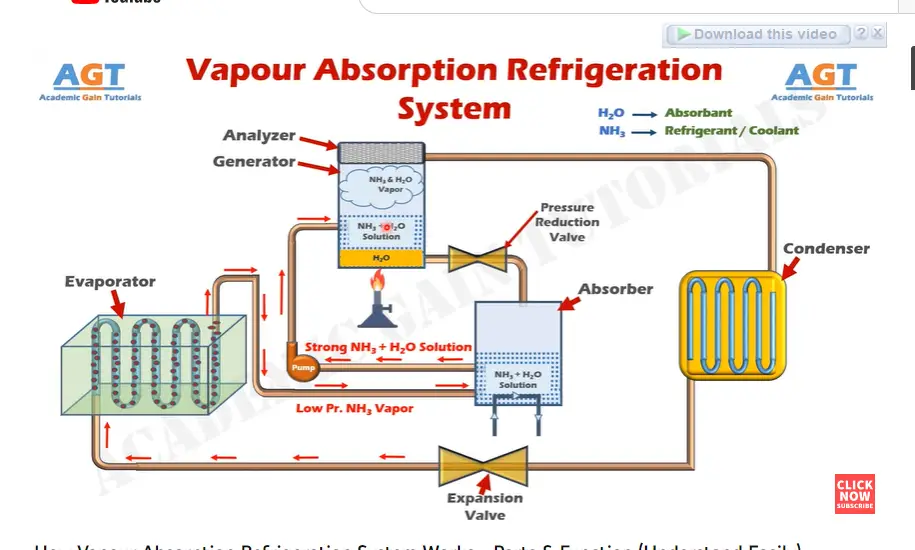Ever heard of a vapor absorption refrigeration generator? If not, you’re in for a treat! This energy-efficient, environmentally-friendly cooling system is perfect for homeowners like you. Let’s dive into the basics and see what makes it stand out from traditional refrigeration methods.

Table of Contents
Principles of Refrigeration
Before we get into the nitty-gritty, let’s take a quick look at how refrigeration works. You’re probably familiar with the traditional vapor compression cycle. Well, there’s another approach – the vapor absorption cycle. It uses heat instead of mechanical energy to move refrigerant, making it more energy-efficient.
Components of the Vapor Absorption Refrigeration System
Ready to explore the heart of a vapor absorption refrigeration system? Let’s break down its key components like a band of superstars!
Absorber: The superhero that captures the refrigerant vapor, mixing it with the absorbent. It’s a true reunion, keeping the cycle alive!
Generator: The mastermind that separates the refrigerant from the absorbent, producing high-pressure vapor. It’s the driving force of the show — More details below.
Evaporator: Picture a magician turning liquid refrigerant into vapor, absorbing heat from the surroundings. Poof! Your space gets cooler!
Condenser: Like a tightrope walker, it turns the high-pressure refrigerant vapor into liquid, releasing heat in the process. Graceful and smooth!
Pump: The powerhouse lifting the absorbent solution back to the generator. It’s the unsung hero, tirelessly working behind the scenes!
Heat exchanger: Imagine two dance partners, swirling around each other, exchanging heat but never touching. That’s the heat exchanger’s elegant performance!
Expansion valve: The guardian of pressure, controlling the flow of refrigerant into the evaporator. It’s the bouncer of the refrigeration club!
Each component plays its part, creating harmony and keeping your cooling system rocking.
The Generator in a Vapor Absorption Refrigeration System
Now, let’s talk about the star of the show: the generator. What does it do, and why is it so important?
Function of the Generator in a Vapor Absorption Refrigeration System
Let me spill the beans on its crucial role…
Separator extraordinaire: Picture the generator as a talented DJ, mixing the beats but also knowing when to split ’em. It separates the refrigerant and absorbent, keeping the party fresh!
High-pressure maestro: Like a fire-breather, the generator turns up the heat, producing high-pressure refrigerant vapor. It’s the life of the party, fueling the whole system!
Social butterfly: The generator doesn’t just do its own thing – it’s all about teamwork! It interacts with other components, keeping the cycle dancin’ to the rhythm of cool.
In short, the generator is the heart and soul of the vapor absorption refrigeration system, pumping out cool vibes and keeping things chill!
Types of Generators used in Vapor Absorption Refrigeration Systems
Are you curious about the different types of generators in vapor absorption refrigeration systems? Let me paint a picture for ya!
Direct fired: Imagine a flame, heating the refrigerant-absorbent directly. Efficient, right? That’s direct fired generators for you.
Indirect fired: Picture a hot wall with the refrigerant-absorbent on the other side. No direct contact, but still heating things up!
Heat exchanger type: Think of two liquids, one hot and one cold, separated by a barrier. They exchange heat, but never touch. Clever, huh?
Heat pump-assisted: Picture a heat pump lending a helping hand, boosting the system’s efficiency. A true team player!
So, which one’s right for you? Depends on your needs and how you like your energy served!
Common Refrigerant-Absorbent Pairs
You might be wondering what substances are used in this process. Here are some common refrigerant-absorbent pairs:
- Ammonia-water
- Water-lithium bromide
- Other emerging pairs
Design and Performance Parameters of Generators
Now that we’ve covered the basics, let’s look at some design and performance factors that make these systems work well.
Heat Source Selection
One of the first things to consider is the heat source for your generator. Some options include:
- Steam
- Hot water
- Waste heat
- Solar energy
- Geothermal energy
Generator Design Considerations
When designing a generator, there are several factors to consider:
- Heat transfer area
- Material selection
- Refrigerant-absorbent flow rate
- Temperature and pressure conditions
Performance Evaluation Metrics
How do you know if your generator is performing well? Here are some key metrics:
- Coefficient of Performance (COP)
- Specific cooling capacity
- Efficiency
- Energy consumption
Applications of Vapor Absorption Refrigeration Generators
Now you might be wondering, “Where can I use a vapor absorption refrigeration generator?” Let’s explore some common applications.
Industrial Applications
These generators are great for various industries, such as:
- Food and beverage industry
- Pharmaceutical industry
- Chemical industry
Commercial Applications
Commercially, vapor absorption refrigeration generators are used for:
- Air conditioning
- Cold storage
- Ice-making
Remote and Off-Grid Applications
These generators are also perfect for remote and off-grid applications, including:
- Rural electrification
- Telecommunication stations
- Military installations
Advantages and Limitations of Vapor Absorption Refrigeration Systems
Finally, let’s weigh the pros and cons of vapor absorption refrigeration systems.
Advantages
There are several benefits to using a vapor absorption refrigeration generator:
- Energy efficiency
- Environmental benefits
- Utilization of waste heat
- Quiet operation
Limitations
However, there are also a few drawbacks:
- High initial investment
- Maintenance requirements
- Limited operational flexibility
Future Trends and Research Directions
As we look to the future, vapor absorption refrigeration systems continue to evolve. Here are some areas of focus:
Emerging Technologies and Innovations
Researchers are working on:
- Advanced heat exchangers
- New refrigerant-absorbent pairs
- Smart control systems
Integration with Renewable Energy Sources
Vapor absorption refrigeration generators can be integrated with renewable energy sources like:
- Solar-assisted systems
- Geothermal-assisted systems
- Hybrid systems
Challenges and Opportunities
As vapor absorption refrigeration generators gain popularity, we face:
- Market penetration challenges
- Technological advancements
- Environmental regulations
- Energy policies